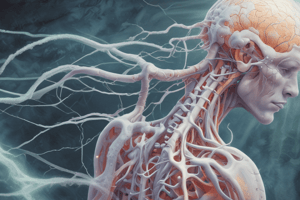Podcast
Questions and Answers
What characterizes the initial manifestation of syringomyelia?
What characterizes the initial manifestation of syringomyelia?
- Bilateral dissociated sensory loss in pain and temperature (correct)
- Complete loss of all sensory modalities
- Loss of touch sensation in the upper limbs
- Flaccid paralysis of the lower limbs
Which part of the spinal cord is most commonly affected by syringomyelia?
Which part of the spinal cord is most commonly affected by syringomyelia?
- Cervical and thoracic segments (correct)
- Thoracic and sacral segments
- Lumbar segments
- Cervical and lumbar segments
What occurs as the disease of syringomyelia progresses?
What occurs as the disease of syringomyelia progresses?
- Destruction of neurons in the gray matter (correct)
- Increased sensitivity to pain
- Complete recovery of sensory functions
- Deterioration of only the white matter
Which of the following correctly describes a manifestation of tabes dorsalis?
Which of the following correctly describes a manifestation of tabes dorsalis?
What type of paralysis is associated with the anterior horn cells affected by syringomyelia?
What type of paralysis is associated with the anterior horn cells affected by syringomyelia?
What causes sensory ataxia in tabes dorsalis?
What causes sensory ataxia in tabes dorsalis?
In syringomyelia, what happens to the ascending spinothalamic tracts?
In syringomyelia, what happens to the ascending spinothalamic tracts?
What is the primary underlying cause of tabes dorsalis?
What is the primary underlying cause of tabes dorsalis?
Study Notes
Sensory Disturbances in Central Nervous System
Syringomyelia
- A disorder of unclear origin characterized by progressive damage to gray matter surrounding the spinal central canal.
- Most frequently affects the lower cervical and upper thoracic segments of the spinal cord.
Initial Manifestations
- Cavitation and enlargement of the spinal central canal damage crossing axons of second-order neurons responsible for pain and thermal sensations.
- Results in bilateral dissociated sensory loss, specifically the loss of pain and temperature sensation while other sensory modalities remain intact, exhibiting a "jacket distribution."
Progression of Disease
- As central cavitation expands, further destruction occurs in gray matter neurons.
- Anterior Horn Cells (AHCs) damage leads to flaccid paralysis in both upper limbs, presenting as lower motor neuron lesions.
- Lateral Horn Cells (LHCs) damage can result in Horner's syndrome.
Later Stages
- Destruction of white matter affects ascending and descending pathways.
- Interruption of dorsal columns results in loss of fine touch and proprioceptive sensations.
- Interruption of spinothalamic tracts leads to loss of pain, temperature, and crude touch sensations, affecting body areas innervated below the lesion level.
- Damage to descending motor pathways causes spastic paralysis in muscles innervated below the lesion, classifying as upper motor neuron lesions.
Tabes Dorsalis
- Primarily arises as a complication of syphilis, causing significant neurological impairment.
Mechanism of Action
- Characterized by constrictive fibrosis affecting spinal dorsal roots at their entry into the spinal cord, leading to degeneration of dorsal root fibers.
- Degeneration predominantly impacts mechanoreceptive fibers in the dorsal columns as well as pain fibers.
Clinical Manifestations
- Initial loss of tactile and proprioceptive sensations includes loss of fine touch, vibration, and proprioception.
- Loss of proprioceptive feedback results in sensory ataxia, marked by jerky, exaggerated, and irregular movements.
Studying That Suits You
Use AI to generate personalized quizzes and flashcards to suit your learning preferences.
Related Documents
Description
Explore the concept of sensory disturbances, specifically focusing on syringomyelia. This quiz delves into the definition, common sites of occurrence, and manifestations of this neurological disorder. Enhance your understanding of the central nervous system's functioning and its disorders.




